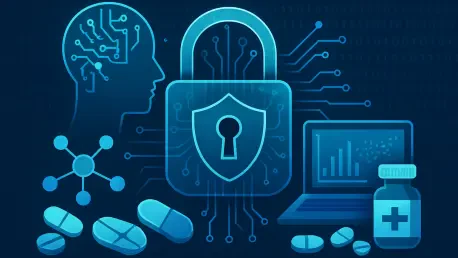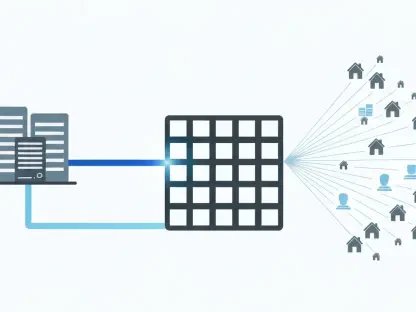The rapid integration of artificial intelligence (AI) into the pharmaceutical industry has brought forth a blend of innovation and urgency. AI’s potential ranges from revolutionary advancements in drug discovery to the streamlining of clinical trial processes. However, the symbiotic relationship between AI and pharmaceuticals also unveils an unsettling dilemma—data security vulnerabilities. Firms find themselves grappling with the paradox of harnessing cutting-edge AI capacities while striving to maintain the integrity and confidentiality of sensitive data. Alarmingly, a significant portion of pharmaceutical companies have inadequate automated controls to shield against unauthorized AI exposure, thus posing significant compliance and competitive risks. This scenario underscores the pressing need for pharmaceutical companies to fortify their digital infrastructures, aligning with regulatory mandates without stifling technological progress.
Striking the Balance: AI Advancements and Security Vulnerabilities
The pharmaceutical industry’s increasing reliance on AI has opened new vistas in research and development. AI facilitates unprecedented efficiencies in identifying drug targets, predicting molecular behavior, and personalizing treatment regimens. Yet, juxtaposed with these advancements is a prevalent vulnerability—the compromised security of proprietary data. A staggering 83% of surveyed companies reveal a lack of sufficient automated controls to secure AI-processed data. This susceptibility not only jeopardizes data integrity but also exposes companies to potential breaches that could engender significant financial and reputational damage. For pharmaceutical companies, mitigating these vulnerabilities is paramount as they navigate the intricate landscape of digital transformation while safeguarding investments in research and proprietary molecular data.
Proprietary information remains one of the industry’s most guarded assets; a breach could lead to the dissemination of billions of dollars in research and undermine competitive advantage. Current practices largely rely on manual reviews and policy frameworks that, on their own, are ill-equipped to face the complex challenges posed by rapid AI advancements. Human error, underscored by high-pressure work environments, further exacerbates these risks. As AI continues to integrate into critical functions, the disconnect between high-level security policies and actual practice becomes more pronounced. To strike a harmonious balance, companies must pivot to data-driven, technical solutions that provide real-time monitoring and automated incident response capabilities—ultimately minimizing the likelihood of inadvertent data exposure.
Bridging the Regulatory and Compliance Gap
Pharmaceutical companies are well-versed in navigating the labyrinth of global regulations aimed at protecting sensitive data. As AI applications proliferate, compliance with regulations like the Health Insurance Portability and Accountability Act (HIPAA) in the United States and the General Data Protection Regulation (GDPR) in Europe becomes increasingly complex. The rapidly evolving oversight measures demand stringent security frameworks that transcend traditional compliance strategies. Conventional methods predicated on policy adherence and employee training are proving inadequate in a dynamic AI landscape. The gap between executive perception and actual compliance practices further compounds the issue, leaving firms vulnerable to potential regulatory breaches and associated penalties.
Bridging this compliance gap necessitates the deployment of robust, technology-driven governance solutions. Automated data classification systems, capable of adapting to evolving regulatory requirements, present a formidable frontline defense against data breaches. Real-time monitoring tools offer increased visibility into data interactions, aiding in the swift identification and rectification of anomalies. Implementing these measures fosters a culture of compliance by systematically integrating security protocols into everyday operations rather than relegating them to the periphery. As regulatory bodies continue to adapt to technological advancements, pharmaceutical entities must remain agile, ensuring that compliance measures are forward-thinking and comprehensive, safeguarding against future regulatory challenges.
Addressing Human-Centric Security Shortcomings
In the quest to bolster AI-driven innovations, the pharmaceutical industry must critically assess its reliance on human-centric security measures. Employee training programs and policy adherence serve as foundational elements within security frameworks, yet they fall short when not supplemented by automated technological controls. The human factor, characterized by potential oversight and errors, introduces uncertainties that jeopardize the confidentiality of proprietary data. High-pressure environments accentuate these vulnerabilities, often leading to lapses in judgment or adherence to security policies. Transitioning from manual to automated controls is vital to ensure consistent enforcement of security protocols across all operational levels.
Technological advancements offer a suite of sophisticated tools designed to mitigate human errors. Automated data leakage prevention systems, for instance, can provide continuous monitoring and instantaneous response to unauthorized data access attempts. Such systems not only reinforce security measures but also alleviate the burden placed on employees in maintaining compliance. By leveraging AI itself to fortify data governance, pharmaceutical companies can seamlessly integrate robust security controls into their workflows. Concurrently, fostering a culture of security awareness remains crucial, ensuring that employees understand their role in maintaining data integrity while also leveraging technological solutions that provide a safety net against human fallibility.
Strategic Risks and Competitive Disadvantages
The strategic relevance of data integrity within the pharmaceutical sector cannot be overstated. As companies vie for market leadership, the protection of proprietary data such as molecular structures and patient health records becomes a vital aspect of competitive strategy. Once compromised, the repercussions of data breaches extend beyond immediate financial loss, manifesting as enduring competitive disadvantages and eroded trust among stakeholders. The irreversible nature of data exposure underscores the urgency for pharmaceutical companies to prioritize robust security measures alongside their AI-driven initiatives.
Molecular data, vital for drug discovery and product differentiation, is particularly susceptible to AI-driven breaches. Given the industry’s high stakes, a single exposure could equate to the loss of years of research and development investment. Moreover, patient health information, critical to personalized medicine advancements, requires unwavering confidentiality to maintain public trust. Strategic foresight into potential data vulnerabilities allows firms to adopt proactive measures, enabling the prediction and prevention of breaches before they occur. By embedding security protocols within the strategic framework, companies can mitigate the risk profile associated with AI integration, safeguarding their competitive standing and reinforcing stakeholder confidence.
Shifting Towards Automated Data Security Solutions
The path forward for pharmaceutical companies is clear; the migration from manual, human-dependent security frameworks to sophisticated, automated solutions is imperative. Addressing the challenges posed by AI data security requires a strategic embrace of advanced technologies, such as machine learning algorithms capable of detecting and analyzing anomalies in real-time. These technologies unfurl a predictive lens, empowering firms to identify potential threats before they materialize into breaches. In the complex realm of pharmaceuticals, the ability to preemptively address security lapses is invaluable.
Implementing automated solutions involves a multi-faceted approach, encompassing software tools designed to enforce protective measures seamlessly across data channels. In particular, real-time data monitoring systems provide comprehensive oversight, ensuring any deviation from established norms is flagged immediately. Adaptive security technologies, capable of learning and evolving alongside AI applications, represent the forefront of innovative data protection strategies. Firms adopting these measures not only fortify their defenses but also align with best practices in global regulatory compliance, ensuring that technological ambitions do not compromise data integrity. By placing technology at the core of data security strategy, pharmaceutical companies can confidently navigate the evolving landscape, securing their investments and fortifying their market foothold.
Concluding Insights and Future Considerations
The pharmaceutical industry’s increasing dependence on AI is transforming research and development by enhancing efficiencies in identifying drug targets, predicting molecular interactions, and customizing treatment plans. However, alongside these advancements, a serious issue arises—the security of proprietary data is often compromised. A significant 83% of companies surveyed report insufficient automated controls to protect data processed by AI. This vulnerability not only threatens data integrity but also opens the door to breaches that can cause immense financial and reputational repercussions. For pharmaceutical firms, addressing these vulnerabilities is crucial as they navigate digital transformation while protecting their investments in research and proprietary molecular data.
Proprietary information is among the industry’s most valuable assets; a breach could leak billions of dollars’ worth of research, destroying competitive edge. Current safeguards mostly involve manual reviews and policy frameworks, which alone are inadequate against the rapid challenges of AI progress. Human errors, often heightened by high-pressure work environments, compound these risks. As AI continues to permeate crucial functions, the gap between high-level security policies and actual practices becomes increasingly evident. To achieve a balanced approach, companies need to adopt data-driven techniques offering real-time monitoring and automated incident response to reduce the chances of accidental data exposure.









